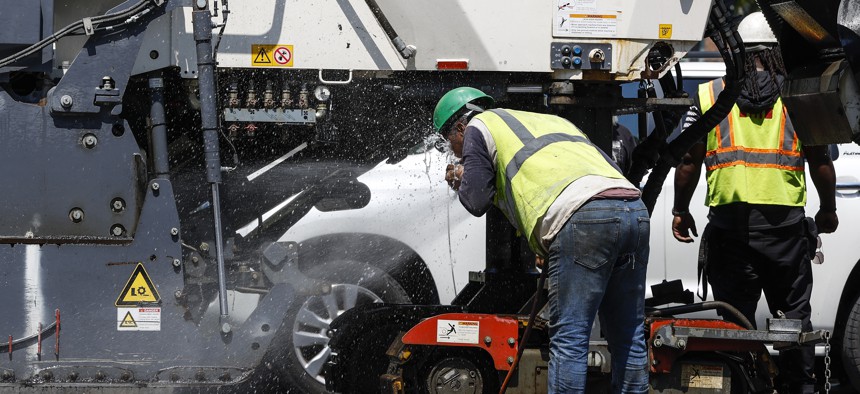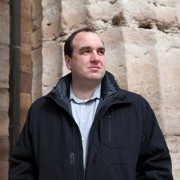Policy
As temperatures spike, state and local governments act to protect residents, workers
Governments geared up protective measures against the dangerous weather baking nearly every part of the country, including Florida.

A construction worker splashes water on his face as a heat wave blanketed the East Coast this past weekend. Photo by Anna Moneymaker/Getty Images
No natural phenomenon kills more people in the U.S. than heat, which takes the lives of about 600 Americans annually. That’s why public officials from the White House to city halls are scrambling to help their residents survive and cope with the unprecedented hot spell that has engulfed the country this month.
Half the U.S. population was under heat watches and warnings at some point last week, capping off a month that scientists predict will be the warmest globally on record.
City officials, well aware of the catastrophic potential of excessive heat, have activated plans to help residents reduce their temperatures with splash pads, pools, spray showers, watering stations and cooling centers, including libraries.
“Access to cooling is a matter of life and death,” warned New York City Mayor Eric Adams last week. Ashwin Vasan, the city’s commissioner of health and mental hygiene, said 80% of the city’s heat stroke deaths in recent years involved people whose homes did not have air conditioning. “The best way to prevent heat illness is to stay in a cool indoor air-conditioned place,” he said. “A fan is not enough.”
In Florida, Miami-Dade County – which declared its first ever heat emergency last month – has sweltered under three-digit temperatures. Its elected officials recently legislated some relief for outdoor workers.
Miami-Dade Commissioners Marleine Bastien and Kionne McGhee, a former Florida House Democratic leader, co-sponsored an heat ordinance that passed on first reading. On a day when the heat index is 90° F or more, workers would be required to have a ten-minute break in the shade and water breaks every two hours. A new county Office of Workplace Health and Safety also will be created.
In Phoenix, where temperatures have hit 119 degrees several times this week, the city is under a court order to clear a large homeless encampment called The Zone to prevent heat deaths. Mayor Kate Gallego said the city is working with the federal government, local nonprofits and faith organizations to help people who are still outside.
“Sometimes, it’s gel towels that help cool people who choose to be outside. And sometimes, it's the more than 4,000 cases of water that we have deployed. We have a robust network of cooling centers, about … 62 in our region. And those can be important. But my goal would be to get people inside in air-conditioned environments,” she told NPR.
Gallego appeared via video at a White House event Thursday with President Joe Biden, where she said Phoenix was “on the front lines of climate change.”
She touted a local program called Cool Callers, where residents sign themselves or someone they know up for visits from volunteers who can provide help during the hot streak. The city is also exploring resilient, energy efficient housing made from shipping containers to provide shelter for people without homes, which workers can build indoors without being exposed to the brutal heat outside, she explained.
San Antonio Mayor Ron Nirenberg also joined Biden and Gallego at the event. He said the city is offering free transportation to residents to get to cooling centers.
But Nirenberg noted that a new Texas law could undermine future efforts to protect workers in the city during heat waves. The so-called Death Star law passed this month by Republican state lawmakers will preempt a vast swath of local laws including those requiring that construction workers get water breaks.
“Texas cities are in a battle with the state for local control,” Nirenberg told Biden, “but we’re going to do everything possible to protect our most vulnerable workers, especially those outdoor workers for basic things like being able to access water breaks.”
The president convened the event to tout his administration’s efforts to address the dangers of the current heat wave. The Labor Department issued its first-ever heat hazard alert, putting employers on notice that they must protect workers from the extreme conditions. The department will also step up enforcement of heat-related rules, especially for industries such as construction and agriculture.
“We should be protecting workers from hazardous conditions,” Biden said. “Construction workers who literally risk their lives working all day in blazing heat, and in some places don’t even have the right to take a water break. That’s outrageous."
The administration also announced an increase of $7 million from the Inflation Reduction Act for weather forecasting and $152 million from the 2021 infrastructure law to improve drinking water infrastructure in California, Colorado and Washington.
Gallego, the Phoenix mayor, called for more federal action, including devoting more money from the Low Income Home Energy Assistance Program, known as LIHEAP, for residents to pay their air conditioning bills in places with extreme heat. “Even when the heat wave is over, many of our families may see their largest ever energy bill in their mailboxes,” she said.
She also backed an increasingly popular idea to allow federal disaster declarations for extreme heat events, which would help states mobilize in the same way they would for winter storms, floods, hurricanes or tornadoes.
City & State Florida contributed reporting. A version of this story was first published on Route Fifty.
NEXT STORY: 'Blatant distortion': Head of Black history for Palm Beach County schools blasts new guidelines
